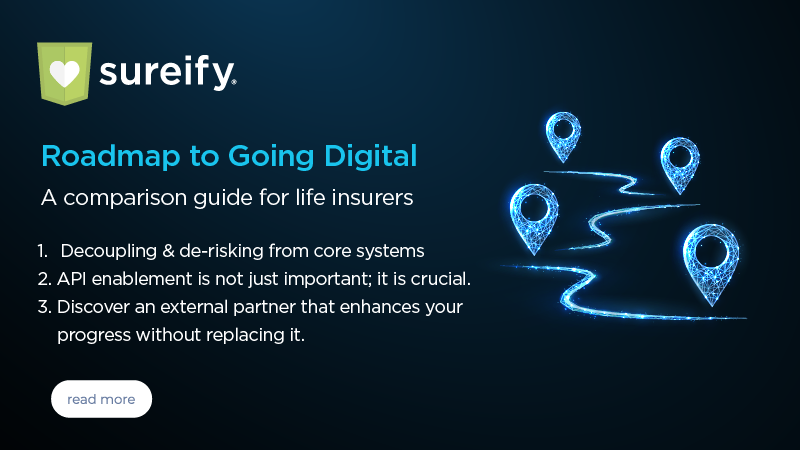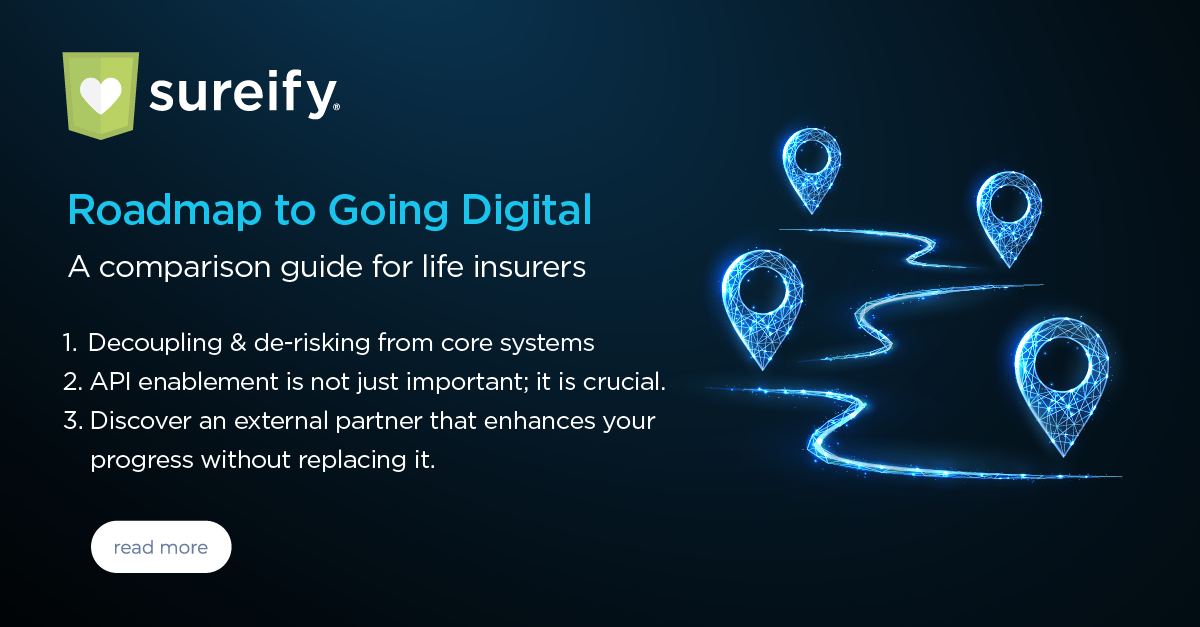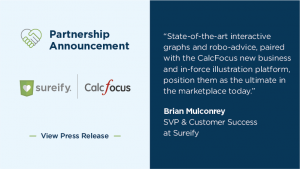A comparison guide for life insurers considering the future
In 2023, we are well on our way to a digital world. Life insurance, like other industries, has seen the signs and proceeded accordingly, knowing that it will be a never-ending journey. For many in our industry, the first leg on the voyage toward digital capability has been reached. For others, the map is out and decisions are being made about the best route to take.
As with any trip, there is anticipation and there is trepidation among industry leaders. The idea of “getting there” is exciting, but the “what ifs” have derailed more than a few journeys. What if the car doesn’t make it? What if traffic keeps us from getting to our destination? What if we get to the location and find out that it’s not what was expected at all, and what if we didn’t prepare and pack properly for that unexpected result?
My role at Sureify is to help life insurers and annuity carriers set goals that are reachable and then prepare them to get to the destination. That’s why I’m writing this. It’s not necessarily to be a “thought leader”, but to give some guidance on what I have found to be the biggest hurdle on the road to digital modernization – the decision to build an internal team that can implement technological advancements, or to buy the technology from an experienced insurtech.
– – – – – – – –
Over the past 12 months, we have met with more than 25 carriers, trying to understand better where they are with their digital transformation efforts. The common denominator with all carriers we spoke with is that they’re excited about the digital age but aren’t sure what it means for their company. The current journeys varied:
- Some chose to cruise along with legacy tools and technology that have worked until now. Today, they face large amounts of technical debt and can’t decouple or consolidate systems of record.
- Other carriers have slapped a new portal UI to “modernize,” knowing they still drive to a PDF form to update beneficiaries or change an address. This keeps call center costs high and agent/policyholder experience low.
- Some carriers have embarked on their digital journey and done things like setting up data lakes/hubs. Too often, though, these carriers hit a wall with areas like API enablement strategies or “multiple inconsistent data definitions. (It makes sense to think of all the variations of the term ‘premium;’ there’s rider premium, 1035 premium, annual premium, modal premium, single premium).
The curiosity led me to call in favors from highly-regarded industry veterans, employed by reputable carriers, and representing business leadership from underwriting to operations to innovation. Because, sometimes, experiential research provides more value than pure statistics for a topic like digital development. Often, there is a story that gives context that numbers simply can’t represent.
During Zoom calls and impromptu discussions at the hotel lobby bar during conferences, it became clear that no one was looking for a roadmap that showed only hazards or a single product as the only route to modernization. Instead, I found that the life insurance/annuity industry is searching for a deeper understanding of what it means for carriers to go digital and stay digital through effective data orchestration. Most importantly, these insurance veterans said that those in the industry need to know what to consider, whether they are at a carrier already embarking on this journey or just getting started.
These concerns are incredibly relevant and eye-opening. After speaking with several experts, the consensus is that there’s no possibility for an “opt-out” – life insurers must update their infrastructure to modernize their systems. This includes creating a single system to manage portals, streamline new business, handle inforce business servicing transactions for policyholders, support the success of agents/advisors, provide easy access to all data for call center and operations teams, maintain the needs of the distribution team for new products, make sure that API from that legacy closed block of business can … wait, does it even have a server with internet access?
You get the point. It feels overwhelming, but failure to accommodate these modern demands could result in a bumpy road over a cliff for the carrier. They could face acquisition by larger companies, much like what we’ve seen as a recent trend in the financial services world (e.g., broker/dealer, wealth management.) Others might see significant leadership changes. As one LH&A carrier core systems expert put it, “If you notice, there have been a lot of changes at the C-Level at carriers, specifically CEOs and CTOs. Many of us haven’t paid attention, but you can see that the industry is making moves to hire digital forward-thinking leaders who are 100% committed to spending the time, energy, and budget to go down the digital path.”
That expert is correct. If you need more proof, look at this survey by KPMG, which finds that 72% of CEOs have an aggressive digital investment strategy. The study by Accenture reveals that 92% of insurance executives believe digital technology is crucial for the future success of their organizations. Recent research by Celent shows that over 75% of North American life insurers are considering a cloud deployment approach.
Add to that the current economic climate, in which the number of insurtechs is rapidly growing, thus increasing competition, and 2023 could represent an ideal chance for life insurers to set new digital standards more affordably – not just for their industry but for all sectors globally.
With its longtime customer-centric DNA and one-on-one business model, the life insurance/annuity industry (you can include the worksite/voluntary/group benefit verticals, too) can show the rest of the world how incorporating digital processes throughout the organization can enhance the agent and customer experience rather than fight against it.
The time to act is now. A report from Deloitte advocates that “Carriers should respond to economic pressure and COVID-19–related uncertainties with proactive measures like doubling down on their pandemic-spurred digital enhancements, introducing new products, services, and distribution options, or seeking out previously underserved customer niches.”
More companies are already on their way to digital transformation, mainly because they have no other option. Audiences don’t have time or patience for system glitches or delays because of manual processing. And insurance tech execs know this. A Celent study, “North American Life Insurance IT Priorities and Pressures,” reports that CIOs understand the need for investment in technology, and they prepared their 2023 budgets accordingly. From the study: “Despite the economic and political uncertainties, N[orth] A[merican] life insurers are considering higher investments in technology, as witnessed by the higher proportion planning an increase in IT budgets this year.” Nearly 80% of respondents to the survey said they would increase the IT budget, even with interest rates rising and inflation showing no sign of slowing.
This is also changing the hiring process at carriers. As layoffs from well-known tech companies fill the space with highly qualified employees, IT and database talent is saturating the market, and companies are looking to hire outside-the-box tech thinkers, even if they are not flush with life & annuity experience. A contact from a carrier currently dominating the annuity space said it best: “As recently as three years ago, we’d put out a job posting for enterprise IT or database talent, and if we were lucky, we’d get 4-5 applicants. Now, we’re getting hundreds of resumès to choose from. Some may not have life and annuity experience, but that’s not a deal-breaker anymore – it gives us flexibility.”
It’s a unique approach, but leaders I spoke with were on the fence about hiring leadership roles outside the industry, saying they have already encountered roadblocks. I’ve heard, “I get it, but this is an old industry with old systems.” He explained, “Technical leaders at carriers who have embarked without full vetting have found that they can’t deliver APIs in JSON and have to revert to XMLs or SFTPs. Some have realized that they don’t have any data standardization and that the same data point has different definitions. Others find that those systems, even the new systems they purchased, are Frankensteined together because of employee turnover.”
The best example from a carrier expert: “We can’t even do address changes digitally. We have three different policy admin systems, leaving us too reliant on expensive human processes. That experience is unfair to policyholders, agents, and our internal call center and operations teams.”
That comment may provide the best reason for the “buy”, but life insurance CIOs and their architecture teams looking down the road at the uncertainty of what “digital” truly means have often commented that the expense of a buy is overwhelming. In their words, “Leveraging external resources may be too rich for our blood right now.” I get that – insurtech products, platforms, and guidance can be costly and, frankly, mentally exhausting to pursue. So then, where do carriers find their “inner Buddha” teachings in the search for a middle path of going digital and staying digital?’
We know the technology is here, but the “build or buy” decision remains. Are these routes to the final destination of seamless, effortless digital equal in outcome? What are the differences that have to be figured out? As a life insurer considering the digital future, you are probably looking at the infinite possibilities for modernizing your business. Chief among them – is it better to build internal digital capabilities to save money upfront or accept the technology from a reputable insurtech partner?
Making that decision is intimidating, no matter how you look at it. In all my conversations, though, I have come to a conclusion that may help you simplify your route forward: there are only three things that need to be considered when making that ultimate decision to build or buy: cost, risk, and benefit. I have taken the liberty of putting together some thoughts on each of these considerations that can serve as a sort of GPS when venturing into the digital horizon.
Cost
Whether you build or buy, the cost of modernizing can be significant. But to deftly manage the flow of business from inception to completion and effectively access and leverage data to maintain a competitive advantage, the expense is necessary. Failing to allocate resources to digital transformation to avoid missing out on a digitally enabled market’s opportunities. It’s an investment you can’t afford to miss.
“Build” Costs
- Development/IT Costs: Creating a robust digital infrastructure requires substantial investments in technology, software development, and IT resources.
- Infrastructure Setup: Establishing the necessary infrastructure, such as servers, networking equipment, and data storage systems, can be a significant upfront cost.
- Core Modernization: Access to data held in various record systems can cause a host of experience problems. Costs for necessary data upgrades and consolidations will likely require the assistance of multiple vendors.
- Security & Compliance: Building a secure digital infrastructure involves investing in cybersecurity measures to protect sensitive customer data from potential threats. Compliance with industry regulations and data privacy laws may also require additional investments in ensuring data protection and privacy.
- Maintenance and Upgrades: The costs of ongoing support, bug fixes, software updates, and addressing compatibility issues with evolving technologies are significant. As technology evolves, so will the cost of implementation and integration.
- Hiring/Training: Developing a digital infrastructure internally means hiring and retaining a skilled workforce capable of effectively managing and maintaining the infrastructure.
- Time/Lost Opportunities: Building a digital infrastructure internally takes time and diverts resources and attention from other core business activities.
“Buy” Costs
- Licensing/Subscription Fees: Insurtech providers typically charge licensing or subscription fees for using their digital platform.
- Implementation and Integration Fees: Insurers may need to invest in system configuration, data migration, and integration with existing internal systems, processes, or third-party applications. These costs can vary depending on the complexity of the insurer’s operations.
- Core Modernization: Partners like Sureify offer a DXP that can utilize current systems of record and adapt to a quickly changing landscape by building a middle ground where data can be withdrawn and deposited. This can lead to lower costs vs. trying to modernize core systems organically.
- Training and Change Management: Introducing a new digital platform means training employees on its functionalities, workflows, and best practices.
- Customization and Enhancements: While insurtech platforms offer a range of features and functionalities, insurers may require additional customization or enhancements to align the platform with their specific business processes or unique requirements.
- Support and Maintenance: Insurers should clarify the support and maintenance terms with the insurtech provider and factor in these costs to ensure the long-term sustainability of the digital infrastructure.
Analysis: The cost comparison finds several advantages on the “buy” side. Partnering with an insurtech company for SaaS-based digital enablement provides cost benefits through reduced development costs, flexible subscription pricing, lowered IT and maintenance expenses, rapid implementation, and access to expertise and innovation. Insurers can leverage a vendor’s specialized resources and scalable solutions to enhance their digital capabilities while optimizing cost efficiency.
Risk
While the life insurance business model is founded on managing risk, today’s insurtech businesses are equally responsible for considering and mitigating potential hazards. As tech companies pioneer new technological solutions and disrupt traditional insurance models, they are held to the highest standards where risks are concerned. Like life insurers, their reputations depend on a proven track record of risk management.
Evaluating both industries from this perspective, it’s clear that risks are inherent in both the “build” and “buy” scenarios.
“Build” Risks
- Cost Overruns: Insurers may underestimate the true costs associated with software development, hardware, IT resources, and ongoing maintenance and upgrades. Budget overruns can also occur if unexpected challenges or delays arise during development.
- Time-to-Market Delays: Developing an in-house digital infrastructure requires significant time and effort. Insurers may face delays in implementing and launching the infrastructure, resulting in a longer time-to-market for new products, services, or digital features.
- Limited Expertise: Insurers may need more specialized expertise and resources to build and maintain a robust digital infrastructure. Insufficient expertise can lead to suboptimal solutions, security vulnerabilities, and UX shortfalls that could result in reputational damage.
- Scalability and Flexibility Challenges: Building an internal infrastructure may pose challenges in scaling and adapting to changing business needs. Creating a scalable and flexible infrastructure internally can be complex and time-consuming, potentially hindering agility and growth.
- Maintenance and Upgrades: Insurers are responsible for maintaining, upgrading, and securing their in-house infrastructure. Over time, requirements to keep the infrastructure up-to-date and aligned with industry standards can be significant, diverting resources from core business activities.
- Integration Challenges: Life insurers may need help integrating their internal digital infrastructure with existing legacy systems, third-party applications, or external data sources. Incompatibilities, data migration issues, and interoperability challenges can arise, impacting the efficiency and effectiveness of the overall infrastructure.
- Compliance and Regulatory Risks: Building internally requires ensuring compliance with industry regulations, data privacy laws, and cybersecurity standards. Insurers must invest in robust security measures, data protection protocols, and ongoing compliance efforts.
“Buy” Risks
- Dependence on a “third party”: When insurers rely on an insurtech provider for their digital platform, they become dependent on the capabilities, reliability, and continued existence of the provider. If an insurtech company faces financial instability or operational issues or discontinues its services, insurers may experience disruptions or difficulties maintaining and operating their digital platform.
- Limited Customization and Flexibility: Insurtech platforms often have predefined functionalities and features. While they provide a solid foundation, customization and flexibility may need to be improved.
- Vendor Lock-In: Once insurers adopt an insurtech’s digital platform, switching to another provider or migrating to an in-house solution can be challenging. The costs and efforts of transitioning to a new platform or vendor can be substantial.
- Data Security and Privacy: Insurtech platforms involve transferring and storing sensitive customer and company data. Insurers must thoroughly assess the security protocols, data privacy practices, and compliance measures implemented by the insurtech company to ensure the safety and privacy of their data and their customers’ data.
- Regulatory Compliance: Insurers must ensure that the insurtech platform they purchase complies with industry regulations and data protection laws. Insurers need to conduct due diligence to verify that the platform meets the necessary compliance standards and can adapt to regulatory changes over time.
- Long-Term Cost Considerations: While insurtech platforms may offer cost advantages initially, insurers need to consider the long-term financial implications. Pricing models, subscription fees, or licensing costs may increase over time or be subject to additional customization, support, or upgrade charges.
Analysis: To mitigate risks associated with selecting an insurtech partner, carriers should conduct thorough due diligence that includes evaluating track records, reputation, financial stability, security measures, compliance capabilities, and contractual terms. Engaging in comprehensive discussions and negotiations with the insurtech company is advisable to address concerns, ensure transparency, and establish clear expectations before finalizing the partnership and purchase agreement.
Advantages/Benefits
The benefits of digital enhancement across business functions are countless today. Buyers of life insurance policies and products come from all walks of life, but they all expect an easy, seamless user experience throughout the buying process and beyond. We live in a society where companies like Amazon and Netflix set the standard. Any friction in an experience will inevitably send a buyer to seek a better alternative.
By now, you know that modernization is inevitable, but how it is implemented is a critical strategic decision – and there are advantages to both building internally and buying.
“Build” Advantages/Benefits
- Tailored Solutions: By building their own digital infrastructure, insurers have the flexibility to create customized solutions that align specifically with their business needs, processes, and unique customer requirements.
- Control and Ownership: Building an internal digital infrastructure gives insurers complete control and ownership over their technology stack. This control enables insurers to align their digital initiatives with their overall business strategies and quickly adapt to changing market conditions and regulatory requirements.
- Long-Term Cost Savings: While building a digital infrastructure incurs initial investment costs, it can lead to long-term cost savings. Insurers can eliminate or reduce ongoing licensing fees associated with third-party platforms or software. They also have greater control over maintenance and upgrades. Over time, the ability to optimize and scale the infrastructure internally can result in cost efficiencies.
- Flexibility and Scalability: With an in-house digital infrastructure, insurers have the flexibility to adapt and scale their systems as their business grows or industry dynamics change. Customizing and scaling the infrastructure allows insurers to remain agile, innovate faster, and capitalize on emerging opportunities.
- Data Ownership and Insights: Building an internal digital infrastructure allows insurers to retain ownership and control over their data. This ownership enables insurers to collect, analyze, and derive actionable insights from their data assets, contributing to more informed decision-making, targeted marketing efforts, and enhanced risk management practices.
“Buy” Advantages/Benefits
- Expertise and Specialization: By partnering with an insurtech, life insurers can leverage the specialized knowledge and experience of the provider, benefiting from their deep understanding of digital trends, best practices, and innovative solutions.
- Accelerated Time-to-Market: Insurtechs typically offer pre-built digital platforms and solutions that can be quickly customized and deployed. This accelerated implementation timeline enables life insurers to bring their digital capabilities to market faster, gaining a competitive edge and capturing opportunities in a rapidly evolving digital landscape.
- Cost Efficiency: Partnering with an insurtech can result in cost savings and improved cost efficiency. Insurers can avoid substantial upfront investments in developing their own digital infrastructure, as insurtechs provide ready-to-use solutions. Additionally, insurtechs often offer subscription-based pricing models or pay-as-you-go options, allowing insurers to align costs with usage and scale their digital capabilities as needed.
- Scalability and Flexibility: Insurtech platforms are designed to be scalable and flexible, accommodating the evolving needs of life insurers. As insurers grow, expand into new markets, or introduce new product lines, insurtech platforms can scale accordingly.
- Continuous Innovation: Insurtech companies are at the forefront of digital innovation in the insurance industry. By partnering with insurtechs, life insurers access the latest technological advancements, emerging trends, and innovative solutions.
- Seamless Integrations: Insurtech platforms are designed to seamlessly integrate with existing systems, processes, and data sources. Insurers can avoid the complexities and challenges of integrating disparate systems by leveraging the expertise of the insurtech provider.
Analysis: There are benefits to both the “build” and the “buy” methods of incorporating digital technology into the business of life insurance. The biggest difference comes when considering the purpose of digital. Many life insurance execs I have spoken to say they want to offer their customers the best available options and experiences … but they want to keep the focus on selling life insurance rather than becoming a tech company that happens to offer life insurance products. Since there are benefits on both sides, a comprehensive partnership that puts the insurer at the helm and allows for extensive input on tech development is often the best option.
Conclusion: So how can you reach the destination?
As insurers contemplate the pros and cons of the digital transformation puzzle, the ability to “improvise, adapt, and overcome” (to quote the old US Marine Corps motto) will be the difference between success and disappointment for carriers and, arguably, careers.
When I first entered the insurtech industry, advisors – already accustomed to a decade of internet access – were surprised that we could manage their books of business entirely online through CRM. Now, those same advisors urged us to develop a mobile application for scheduling and taking essential notes about clients. They ping me on LinkedIn for advice on which AI tools effectively manage and grow their B-C clients and identify opportunities across various disciplines such as wealth management, life & annuities, estate planning services, etc., based on service calls or anniversaries. These increasingly sophisticated insights and requests prove that the entire business world has shifted dramatically toward digital technology in a relatively short time.
It’s not a surprise that growth in FinTech and InsureTech capabilities has accelerated progress, but what is surprising is that the sense of urgency to adapt or alter mentality has not changed at home offices.
One of my colleagues said it best in a response to a recent LinkedIn post, “Fear causes insurance carriers to be so conservative that they are afraid to make the spend to get out of their legacy IT debt. They always find a reason to believe that “now is not the right time.”
Unfortunately, even carrier leaders who believed in what was being presented “back in the day” have continually encountered internal disinterest or skepticisms. Even today, many executives who have come up through the ranks of the traditional life insurance industry may not have a real understanding of how modern consumers interact (such as the Netflix experience), and therefore, might hinder the exploration of new business ideas by denying necessary funding. Some procrastinate by saying “next year” while accumulating technical debt. Still, others can’t agree on priorities and instead opt for yet another adjustment to an eApp system or trendy buzzwords like “no-code.” These leaders rightfully recognize that the landscape changes fast, but they see this rapid evolution as all risk with few or uncertain rewards.
The ultimate destination of digital capability should be seamless user experience in every interaction, and that means initiatives that build on the potential to grow and support future endeavors. Building today for value tomorrow won’t be a “big bang” event or without cost. It will take a comprehensive analysis of the entire landscape and decoupling and consolidating data and automation. Above all, it will take a good partner who can identify untapped opportunities to complement any work that has already been done rather than replace it. That’s the value of a trusted insurtech partner – it goes beyond fueling up with SaaS software. It’s an investment in the team that will orchestrate carrier transformation today to uphold tomorrow’s possibilities.





